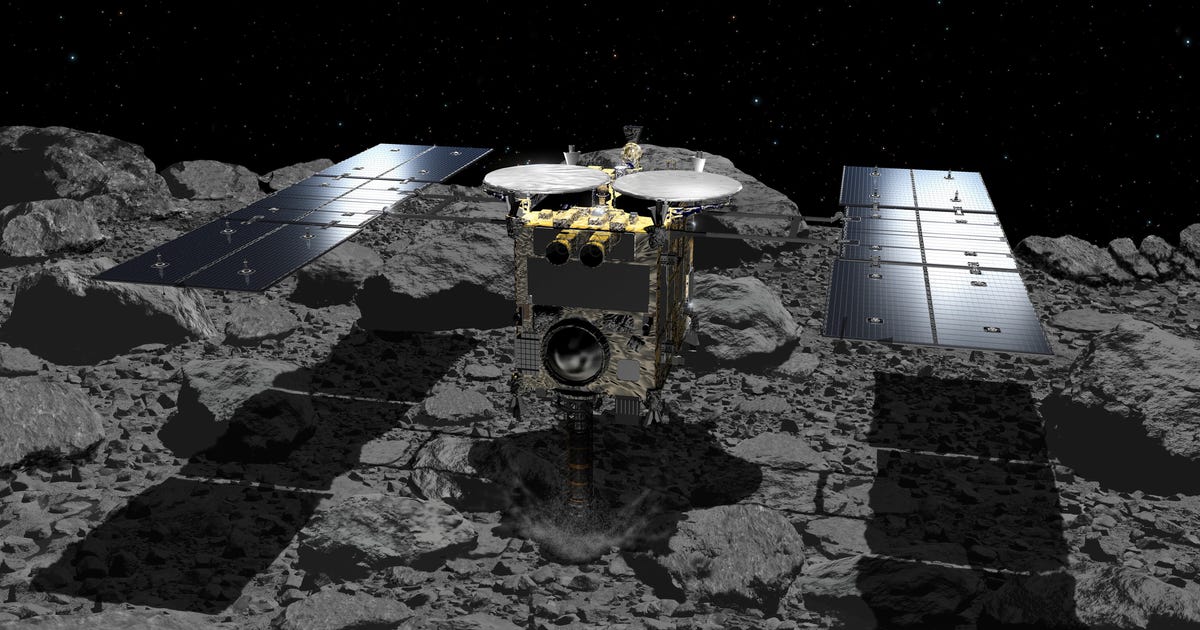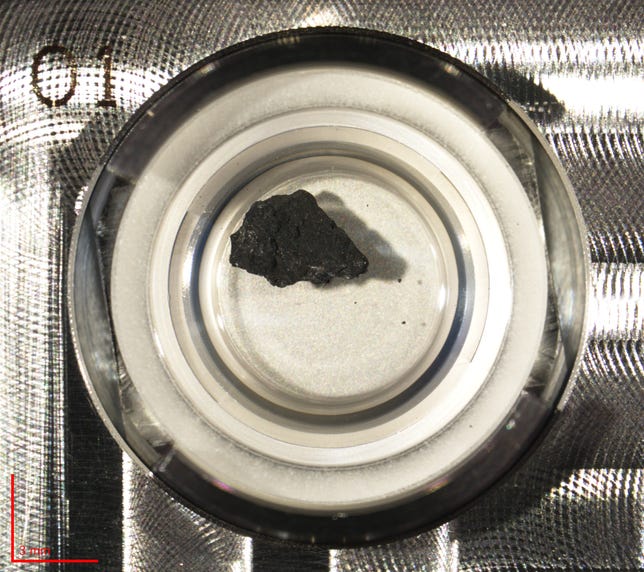
What is going down
Japan’s house company has carried out an preliminary research of samples from the 4.6-billion-year-old asteroid Ryugu.
Why it issues
The samples are one of the crucial maximum primitive fabrics ever recovered from house and can lend a hand us perceive the earliest epoch of our sun device.
When Japan’s Hayabusa2 spacecraft slung its treasure chest of asteroid samples towards Earth in December 2020, the scientists and engineers guiding the samples house erupted right into a spherical of applause. After an eight-year undertaking to the 4.6-billion-year-old asteroid Ryugu, items of the traditional rock have been in spite of everything on their method to Earth.
Now, some eighteen months later, the chest has been opened and its treasures subjected to the overall gamut of medical analyses. The Jap house company, JAXA, had an inkling that the dear fabrics within Hayabusa2’s pattern tablet can be of significant medical worth — and the preliminary chemical research displays simply how exceptional the company’s samples are.
In a learn about, printed within the magazine Science on June 9, JAXA scientists give you the first in-depth review of samples recovered from Ryugu since they have been returned to Earth.
“We discovered Ryugu is the hottest ever CI chondrite,” mentioned Shogo Tachibana, JAXA’s lead scientist at the preliminary pattern research.
What this implies is the fabrics recovered from Ryugu are essentially the most primitive that people have ever been ready to research on Earth. They supply a portal to the very early days of the sun device, when the solar used to be just a fledgling superstar and the planets have been simplest simply beginning to shape. Regardless that the learn about launched Thursday is a big milestone in working out Ryugu, it is simply step one in comprehending the sun device and our position in it.
This is why it issues.
Nabbing rock from the Hayabusa2 pattern tablet is a mild procedure.
JAXA
Adventure to the Dragon Palace
Japan’s Hayabusa2 undertaking introduced in 2014 on a adventure to retrieve samples from the asteroid Ryugu, named for the “Dragon Palace” in a well-known Jap folktale. The asteroid belongs to the most typical elegance in our sun device, the C-type, and is formed like a spinning height. Its orbit across the solar exists past Mars. Some scientists imagine a lot of these asteroids delivered the uncooked fabrics for existence to Earth, and that is the reason why JAXA sought after to research Ryugu and scouse borrow some rock from its floor.
After a four-year adventure, Hayabusa2 rendezvoused with the gap rock after which, in 2019, the spacecraft made two transient touchdowns at the asteroid, hoovering up samples and storing them in a specialised pattern tablet. That pattern tablet landed within the Australian outback in 2020 and its treasured shipment has been moderately controlled since.
The 2 landings on Ryugu snatched away 5.4 grams of subject matter from the skin and subsurface of the asteroid. The fabric is within the type of small pebbles and rocks, ranging in measurement as much as about 0.4 inches. The learn about launched on June 9 took a particularly tiny quantity of the pattern — about 2% of the overall — to inspect the chemistry and construction of the asteroid and draw some conclusions about the way it shaped and remodeled over its existence. Doing so required robust electron microscopes and using spectrometers, which can give main points at the chemical compounds found in an object in line with how the thing displays gentle.
The scientists conclude that Ryugu most probably shaped after an enormous house rock within the early sun device used to be smashed into. The fabric that used to be ejected sooner or later shaped into the spinning-top asteroid we all know as Ryugu. This affect, consistent with the research, most probably came about round 2 million to 4 million years after the sun device shaped. In response to the best way the samples had been altered by way of water, the scientists imagine they are from about 5 million years after the formation of the sun device.
“The whole lot came about in an excessively, very early timing [in regard to] the sun device formation,” says Tachibana.
Cool, proper? However… what does that every one imply?
Why meteorites subject
To know the significance of the samples, it is best to take a look at items of rock that experience fallen to Earth. Scientists name those “meteorites.”
Meteorites will also be categorized into distinct teams in line with their composition and chemistry. Essentially the most uncommon form of meteorites scientists have noticed are referred to as “CI chrondrites” — because the 1800s, now we have noticed simplest 5 meteorites of this elegance fall to Earth. One of the well-known is the Orgueil fall, which came about in France in 1864.

A fraction of Ryugu within the pattern database.
JAXA/ISAS/Ryugu Pattern Database
“[U]nlike different meteorite teams, the chemistry of the CI chondrites hasn’t advanced or been changed, and they may be able to let us know concerning the preliminary composition of the sun device,” says Ashley King, a scientist who leads the Mineral and Planetary Sciences Department on the Herbal Historical past Museum in the United Kingdom.
In a nutshell, CI chondrites are essentially the most primitive rocks now we have ever discovered. They arrive from a time when the sun device used to be simply starting to shape. However the rocks that make it to Earth are altered by way of our environment and the adventure to the bottom. Once they damage into the ambience, they warmth up and new minerals and chemical compounds are shaped after which, after they land, they are altered by way of humidity and interactions with water.
This has been one thing of a puzzle for meteoriticists, the scientists specializing in learning meteorites, as a result of — till Ryugu — we have not had the power to understand what the chemical composition of an asteroid in reality is. That is all modified with JAXA’s research, and it is blowing some meteorite scientists away.
“I am principally caught in awe of this learn about this present day and discovering it arduous to translate into customary phrases how fascinating and essential it’s to have the supply of this kind of meteorite to be had for long term learn about,” famous Gretchen Benedix, a planetary scientist at Curtin College in Western Australia.
To sum it up, scientists now have get entry to to the earliest epoch of our sun device and the results for long term learn about are profound. Call to mind it this fashion: JAXA scientists explored a meteorite that by no means made it to Earth and thus used to be by no means altered by way of the prerequisites on our planet. That is a enormous end result.
“The Ryugu samples are essentially the most chemically primitive extraterrestrial fabrics these days to be had to review and can result in new breakthroughs in our working out of the beginning and evolution of planetary programs,” says King.
Now what?
This primary paper is simply the start for JAXA scientists. Over the following couple of months, it is anticipated many extra information about the samples from Ryugu can be printed, unveiling information about the rock’s magnetism, how it is been suffering from house weathering and its publicity to the sun wind and cosmic rays.
However it is not simply JAXA that is taken with Ryugu. NASA received 10% of the returned samples in December 2021 and can carry out its personal research of the samples, taking a look to check the to find with their very own asteroid sample-return undertaking, Osiris-Rex, which visited the asteroid Bennu in 2020. That undertaking is anticipated to go back samples to Earth in September subsequent yr.
What lies in watch for the scientists to find? The probabilities are unending. Simply this week, studies prompt JAXA had additionally found out amino acids — the “development blocks of existence” — in Ryugu. A complete medical document of Ryugu’s amino acids continues to be to return, however this discovery provides to the perception that natural compounds can have been dropped at Earth from outer house.
As scientists learn about the rock grains from Ryugu, and Bennu, our fuzzy working out of the earliest time in sun device historical past will steadily come into center of attention. Probably, it would even expose the place we come from.
